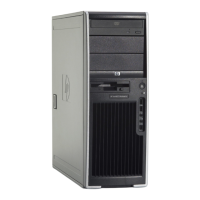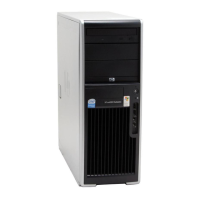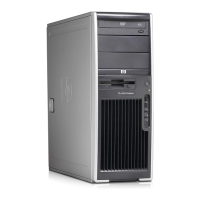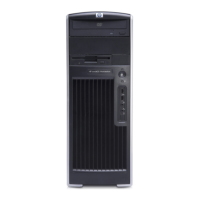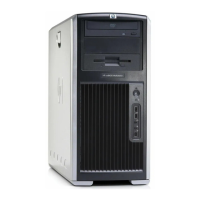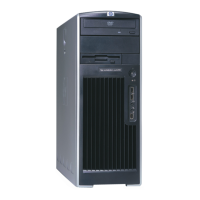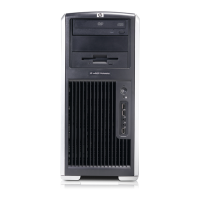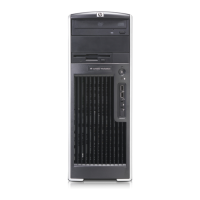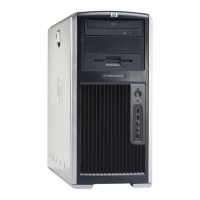Do you have a question about the HP xw4600 and is the answer not in the manual?
| Tcase | 72.4 °C |
|---|---|
| Bus type | FSB |
| Stepping | E0 |
| Processor cache | 6 MB |
| Processor cores | 2 |
| Processor model | E8400 |
| System bus rate | - GT/s |
| Processor family | Intel® Core™2 Duo |
| Processor series | Intel Core 2 Duo E8000 Series |
| Processor socket | LGA 775 (Socket T) |
| Processor codename | Wolfdale |
| Processing Die size | 107 mm² |
| Processor frequency | 3 GHz |
| Processor cache type | L2 |
| Processor lithography | 45 nm |
| Processor manufacturer | Intel |
| Processor front side bus | 1333 MHz |
| Processor operating modes | 64-bit |
| ECC supported by processor | No |
| Thermal Design Power (TDP) | 65 W |
| Number of processors installed | 1 |
| CPU multiplier (bus/core ratio) | 9 |
| Number of Processing Die Transistors | 410 M |
| Audio system | High Definition Audio |
| Product type | Workstation |
| Motherboard chipset | Intel® X38 Express |
| ECC | Yes |
| Internal memory | 2 GB |
| Memory clock speed | 800 MHz |
| Internal memory type | DDR2-SDRAM |
| Maximum internal memory | 8 GB |
| Memory layout (slots x size) | 2 x 1 GB |
| HDD speed | 7200 RPM |
| HDD capacity | 250 GB |
| HDD interface | SATA |
| Optical drive type | DVD-RW |
| Graphics card | - |
| Networking features | Gigabit Ethernet (10/100/1000) |
| USB 2.0 ports quantity | USB 2.0 ports have a data transmission speed of 480 Mbps, and are backwards compatible with USB 1.1 ports. You can connect all kinds of peripheral devices to them. |
| Power supply | 475 W |
| Chassis type | Tower |
| Country of origin | China |
| Processor code | SLB9J |
| Processor ARK ID | 33910 |
| Processor package size | 37.5 x 37.5 mm |
| On-board graphics card model | Not available |
| Depth | 456 mm |
|---|---|
| Width | 168 mm |
| Height | 450 mm |
| Weight | 19000 g |
Details the HP xw4600 Workstation system board architecture and components.
Identifies and describes the front panel components of the HP xw4600 Workstation.
Identifies and describes the rear panel components of the HP xw4600 Workstation.
Provides information on locating serial number and Certificate of Authentication labels.
Lists the physical characteristics and specifications of the HP xw4600 Workstation.
Describes the 475W 80 Plus power supply and its specifications.
Details energy consumption and heat dissipation figures for typical workstation configurations.
Specifies the operating and non-operating environmental parameters for the workstation.
Explains HP's compliance with U.S. EPA ENERGY STAR specifications for energy efficiency.
Discusses the benefits of dual- and quad-core processors for multitasking and demanding applications.
Introduces preloaded software tools to enhance the workstation experience.
Describes how to install and restore Microsoft Windows Vista Business on your workstation.
Provides instructions for creating system recovery DVDs or CDs for backup purposes.
Guides on installing appropriate device drivers for optimal workstation performance.
Details methods for restoring the Windows Vista Business OS to a near-factory state.
Describes how to configure and restore Microsoft Windows XP Professional on your workstation.
Provides instructions for installing and restoring the Red Hat Linux operating system.
Explains how to use the Computer Setup (F10) Utility for system configuration and management.
Describes the functions and specifications supported by the BIOS ROM firmware.
Summarizes capabilities, features, and components of workstation management solutions.
Details methods for deploying customized software images on workstations.
Covers HP tools for managing and updating software on desktops and workstations.
Explains asset tracking data management and security features.
Details how power-on and setup passwords prevent unauthorized access to the workstation.
Describes DriveLock security feature for preventing unauthorized access to ATA hard drives.
Explains the optional Hood Sensor for alerting when the side access panel is removed.
Provides essential warnings and cautions for performing component removal and replacement procedures.
Explains the risks of static discharge and its potential to damage electronic components.
Lists the necessary steps to perform before servicing the workstation.
Details the sequence for removing major workstation components.
Provides instructions for removing and replacing the workstation's side access panel.
Describes the procedure for removing and replacing the front bezel.
Details the process for removing and installing the front panel I/O device assembly.
Provides instructions for removing and replacing the workstation's power supply.
Details the procedure for removing and replacing the system fan assembly.
Describes how to remove and install memory modules in the workstation.
Explains the compatibility and procedures for installing/removing PCI Express cards.
Provides instructions for removing and installing SAS hard drives.
Details the procedures for removing and installing SATA hard drives.
Describes how to remove and install the workstation's processor heatsink.
Provides instructions for removing and installing the workstation's system processor.
Details the procedures for removing and installing the system board.
Offers access to technical support, software updates, and diagnostic tools via the HP Help and Support Center.
Explains the meaning of diagnostic LED codes and associated service actions.
Provides solutions for common workstation and software troubleshooting scenarios.
Offers solutions for basic workstation issues like freezing or incorrect time display.
Details troubleshooting steps for power supply issues and failures.
Provides solutions for common hard drive errors and issues.
Offers troubleshooting steps for display issues, including blank screens and resolution problems.
Provides fixes for common network connectivity and performance issues.
Offers solutions for common memory-related errors and performance issues.
A checklist to find solutions for workstation or software problems before running diagnostics.
Defines the system status indicated by the LED lights on the workstation front panel.
A utility to perform hardware testing and view system configuration information.
Lists Power-On Self-Test error messages, their probable causes, and recommended actions.
Details supported RAID configurations and steps for setting up SAS RAID devices.
Provides steps to configure an Integrated Striped (IS) volume using BIOS.
Offers steps to configure an Integrated Mirroring (IM) volume using BIOS.
Details configuration for Integrated Mirroring Extended (IME) volumes.
Guides on using Intel Matrix Storage Manager for SATA RAID setup.
Steps to configure system BIOS for embedded SATA RAID functionality.
Instructions for creating RAID volumes using the Intel Matrix Storage Manager utility.
Procedures for deleting RAID volumes using the Intel Matrix Storage Manager utility.
Explains how to create setup and power-on passwords using the Computer Setup (F10) Utility.
Details steps to clear power-on and setup passwords by resetting the password jumper.
Describes steps to clear and reset the workstation's CMOS values.
Provides instructions for clearing CMOS using the dedicated Clear CMOS button.
Guides on resetting CMOS settings via the Computer Setup (F10) Utility.
Provides descriptions for various workstation connector pins and signals.
Details the pinout for the SATA drive data and power connectors.
Details the pinout for the SAS drive connectors.
Describes the pinout for the workstation VGA connector.
Outlines general safety guidelines for cleaning workstation components.
Provides instructions for cleaning the workstation's exterior case.
Offers guidance on safely cleaning the workstation keyboard.
Details the procedure for cleaning the workstation's mouse.


